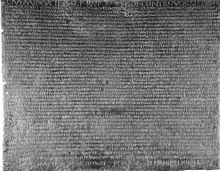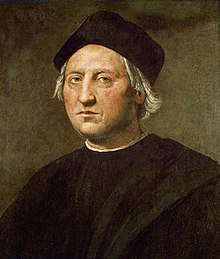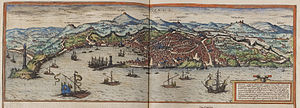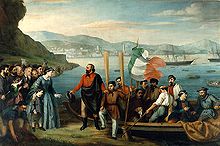History of Genoa

| History of Italy |
|---|
 |
|
|
Genoa, Italy, has historically been one of the most important ports on the Mediterranean.
Prehistory and antiquity
The Genoa area has been inhabited since the fifth or fourth millennium BC.

The city's modern name may derive from the
After the fall of the
For the following several centuries, Genoa was little more than a small centre, slowly building its merchant fleet, which was to become the leading commercial carrier of the
Middle Ages and Renaissance

Before 1100, Genoa emerged as an independent
In 1098, it is said the ashes of
The Genoese have a claim to the creation of the rough denim cloth then called "Blue Jean", from which derives the modern name of jeans, used by sailors for work and to cover and protect their goods on the docks from the weather. During the Republic of Genoa, Genoese merchants and sailors exported this cloth throughout Europe. The production of Genoese lace was also notable.
The collapse of the
In 1218–1220 Genoa was served by the
Genoa's political zenith came with its victory over the
However, this period of prosperity did not last. The Black Death is said to have been imported into Europe in 1347 from the Genoese trading post at Caffa in Crimea on the Black Sea. Following the economic and population collapse that resulted, Genoa adopted the Venetian model of government and was presided over by the Doge of Genoa. The wars with Venice continued, and the War of Chioggia (1378–1381) – during which Genoa almost managed to decisively subdue Venice – ended with Venice's recovery of dominance in the Adriatic. In 1390, Genoa initiated the Barbary Crusade, with help from the French, and laid siege to Mahdia, the Fatimid capital of Ifriqiya.
Though not well-studied, Genoa in the 15th century seems to have been tumultuous. The city had a strong tradition of trading goods from the Levant and its financial expertise was recognised all over Europe. After a period of French domination from 1394 to 1409, Genoa came under the rule of the
In the 15th century two of the earliest banks in the world were founded in Genoa: the Bank of Saint George, founded in 1407, which was the oldest chartered bank in the world at its closure in 1805 and the Banca Carige, founded in 1483 as a mount of piety, which still exists.
Genoa was able to stabilise its position as it moved into the 16th century, particularly as a result of the efforts of Doge Andrea Doria, who granted a new constitution in 1528 that made Genoa a satellite of the Spanish Empire (Siege of Coron 1532/34, Battle of Preveza 1538, Battle of Girolata 1540, Battle of Lepanto 1571, Relief of Genoa 1625). Some Genoese enjoyed remarkable careers in the service of the Spanish crown: notably the maritime explorers Juan Bautista Pastene and Leon Pancaldo, the general Ambrogio Spinola, the naval captain Giovanni della Croce Bernardotte and Jorge Burgues. In the period of economic recovery which followed, many aristocratic Genoese families, such as the Balbi, Doria, Grimaldi, Pallavicini and Serra, amassed tremendous fortunes. According to Felipe Fernandez-Armesto and others, the practices Genoa developed in the Mediterranean (such as chattel slavery) were crucial in the exploration and exploitation of the New World.[10]
The Genoese
During its rise and its apogee, Genoa founded

At the time of Genoa's zenith in the 16th century, the city attracted many artists including
In the 17th century, however, Genoa entered a period of crisis. In May 1625, a French-Savoian army invaded the republic but was
Modern history
With the shift in world economy and trade routes to the New World and away from the Mediterranean, Genoa's political and economic power began a steady decline. Its military power collapsed during the
Well, Prince, so Genoa and Lucca are now just family estates of the Buonapartes.(...) And what do you think of this latest comedy, the coronation at Milan, the comedy of the people of Genoa and Lucca laying their petitions [to be annexed to France] before Monsieur Buonaparte, and Monsieur Buonaparte sitting on a throne and granting the petitions of the nations?" (spoken by a thoroughly anti-Bonapartist Russian aristocrat, soon after the news reached Saint Petersburg).
Although the Genoese revolted against France in 1814 and liberated the city on their own, delegates at the Congress of Vienna sanctioned its incorporation into the Kingdom of Sardinia, thus ending the three century old struggle by the House of Savoy to acquire the city.

The city soon gained a reputation as a hotbed of anti-Savoy republican agitation. Genoa was the centre of an important reform movement that put constant pressure on Piedmont to grant the freedom of the press and more liberal laws. The citizens of the republic would not accept being subjects of an absolute monarchy, wanting to be Italian rather than Piedmontese, though relations with Piedmont improved with the war against Austria. However, after the defeat in the

In the 19th and the early 20th centuries, Genoa consolidated its role as a major seaport and an important steel and shipbuilding centre. In Genoa in 1853,
In 1884
In Genoa the following shipyards were established: Cantiere Navale di Sestri Ponente,
In this period many Genoese emigrated to the Americas (see also Italian diaspora). Among the most interesting experiences of this exodus was the creation of the Buenos Aires district called La Boca, now famous for its colorful houses in the Ligurian style, in addition on 3 April 1905 a group of Genoese boys founded the Boca Juniors football club in Buenos Aires. This is why the fans of Boca Juniors are called "Los Xeneizes", which means the Genoese. In addition, Amadeo Giannini, the son of Genoese immigrants in North America, founded the Bank of America. (See also "Italian Peruvians", "Italian Chileans", "Italian Uruguayans").
During
Genoa also gave rise to numerous industries like the steelworks "S.I.A.C." in
During the fascist period the city of Genoa was united to nineteen municipalities, creating in 1926 what was known as "Greater Genoa", which stretches along the coast for 35 km (22 miles).
In
The exploits during this period of admiral Luigi Durand de la Penne, especially the Raid on Alexandria, are retold in several films, including The Valiant, The Silent Enemy and Human Torpedoes.
After the
During World War II, many
The German search for Jews in Genoa began on November 2, 1943, when two police agents visited the offices of the Jewish community and forced the custodians to turn over their membership lists and summon members to a synagogue meeting the next morning. Many Jews had already left the city by that time, but a majority of those who were seized in Genoa were taken at this meeting. A few members who received the summons were able to escape thanks to a warning from Massimo Teglio. Rabbi Riccardo Pacifici, who until the last moment tried to help other Jews, was captured in the Galleria Mazzini in November of that year. He was murdered at Auschwitz.[18]
In the post-war years, Genoa played a pivotal role in the
Because of population growth, partly due to substantial immigration from other parts of Italy, new neighborhoods have been built. There were years of building speculation and of destruction of two historic districts of the city, the first in 1964 called "Piccapietra-Portoria" and the second in 1974 called "Madre di Dio" location of the house of
In 1991 the MT Haven was shipwrecked off the coast of Genoa, but 1992 marks the rebirth of the city with Genoa Expo '92. Genoa, city home of Christopher Columbus, celebrated the 500th anniversary of the discovery of America. For the occasion, thanks to the intervention of the architect Renzo Piano, the Old Harbour smartened up its face.
The
14 August 2018 was a black day for Genoa: the Ponte Morandi bridge collapsed, killing 43 people.[20]
See also
References
- ^ The objects found during the works for the underground had been exposed in the exhibition Archeologia Metropolitana. Piazza Brignole e Acquasola, held at the Ligurian Archeology Museum (30 November 2009 - 14 February 2010) ([1] Archived December 30, 2013, at the Wayback Machine)
- ISBN 8875633363.
- ^ Marco Milanese, Scavi nell'oppidum preromano di Genova, L'Erma di Bretschneider, Roma 1987 on-line in GoogleBooks; Piera Melli, Una città portuale del Mediterraneo tra il VII e il III secolo a.C., Genova, Fratelli Frilli ed., 2007.
- ^ Giulia Petracco Sicardi, "Genova", in Dizionario di toponomastica, Torino, 1990, p. 355. In Cathedral there is an inscription that says Janus, primus Rex Italiae de progenie gigantum, qui fundavit Genuam temporae Abrahae, in English, "Janus, the first King of Italy, progeny of the giants, who founded Genoa in the days of Abraham." Another theory traces the name to the Etruscan word Kainua which means "New City". Piera Melli (Genova Preromana, 2007), based on an inscription on a pottery sherd reading Kainua, suggests that the Latin name may be a corruption of an older Etruscan one with an original meaning of "new town".
- ^ Paul the Deacon, Historia Langobardorum, II.25
- ^ Gregory I, Registrum Epistolarum, MGH Ep. 2, XI.14, p. 274
- ^ Paul the Deacon, Historia Langobardorum, IV.45
- ISBN 0-8078-4992-8.
- JSTOR 10.7591/j.ctv8j5bm.
- ISBN 978-0-8122-1412-3.
- ^ Early modern Italy (16th to 18th centuries) » The 17th century crisis Encyclopædia Britannica.
- ^ Genoa 1684, World History at KMLA.
- ^ Giorgio Bonacina, Comando Bombardieri - Operazione Europa, pp. 49-50.
- ^ I bombardamenti sull’Italia nella Seconda Guerra Mondiale
- ^ a b Enciclopedia Treccani
- ^ L'atto di resa delle truppe tedesche
- ^ Basil Davidson, Special Operations Europe: Scenes from the Anti-Nazi War (1980), pp. 340/360
- ^ a b "The Jewish Community of Genoa". The Museum of the Jewish People at Beit Hatfutsot. Retrieved 2 July 2018.
- ^ "Italy officials convicted over G8". BBC News. 2008-07-15. Retrieved 2011-04-12.
- ^ Crollo Genova, trovato l'ultimo disperso sotto le macerie: è l'operaio Mirko. Muore uno dei feriti, le vittime totali sono 43
Bibliography
Гавриленко О. А., Сівальньов О. М., Цибулькін В. В. Генуезька спадщина на теренах України; етнодержавознавчий вимір. — Харків: Точка, 2017.— 260 с. —
